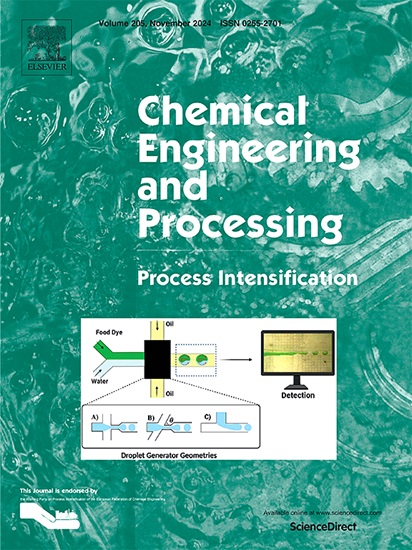Extraction of spores of Metarhizium anisopliae in a rotary drum
IF 3.8
3区 工程技术
Q3 ENERGY & FUELS
Chemical Engineering and Processing - Process Intensification
Pub Date : 2025-07-01
DOI:10.1016/j.cep.2025.110430
引用次数: 0
Abstract
The fungus Metarhizium anisopliae is widely used as a biological control agent of several agricultural pests. The microbe is produced using rice as substrate and the operation of extraction of spores needs improvement. This study explores an effective method for spore extraction using a rotary drum, with controlled variables including extraction time (4 and 8 hours), fill level (0.25 and 0.50), and drum rotation speed (30 and 60 rpm). The extraction efficiency achieved in this bench-scale setup ranged from 32.93 % to 84.24 %. Among the key parameters investigated, only the operation time showed a significant influence, with an 8-hour duration yielding the best performance. This improvement was attributed to the reduction in substrate moisture content throughout the process, indicating it as a critical factor affecting extraction performance. Lower moisture content reduced the shear force and impact required for spore detachment, leading to a more efficient extraction. Additionally, the results suggest that spores are detached through particle collisions rather than by the dragging force promoted by the flowing air, which is essential for predicting optimal process configurations. This research, therefore, lays the foundation for the development of more efficient extraction systems, contributing to the cost-effective large-scale production of bioinsecticides.

转鼓法提取绿僵菌孢子
金龟子绿僵菌是一种广泛应用于多种农业害虫的生物防治剂。该菌以水稻为基质,提取孢子的操作有待改进。本研究探索了一种利用旋转鼓提取孢子的有效方法,控制变量包括提取时间(4和8小时),填充水平(0.25和0.50),鼓转速(30和60 rpm)。实验装置的萃取效率为32.93% ~ 84.24%。在研究的关键参数中,只有操作时间有显著影响,8小时的操作时间效果最好。这一改进归因于整个过程中基材水分含量的降低,表明它是影响萃取性能的关键因素。较低的水分含量减少了剪切力和冲击所需的孢子脱离,导致更有效的提取。此外,结果表明,孢子是通过粒子碰撞而不是由流动的空气所促进的拖曳力分离的,这对于预测最佳工艺配置是必不可少的。因此,该研究为开发更高效的提取系统奠定了基础,有助于经济高效地大规模生产生物杀虫剂。
本文章由计算机程序翻译,如有差异,请以英文原文为准。
求助全文
约1分钟内获得全文
求助全文
来源期刊
CiteScore
7.80
自引率
9.30%
发文量
408
审稿时长
49 days
期刊介绍:
Chemical Engineering and Processing: Process Intensification is intended for practicing researchers in industry and academia, working in the field of Process Engineering and related to the subject of Process Intensification.Articles published in the Journal demonstrate how novel discoveries, developments and theories in the field of Process Engineering and in particular Process Intensification may be used for analysis and design of innovative equipment and processing methods with substantially improved sustainability, efficiency and environmental performance.

 求助内容:
求助内容: 应助结果提醒方式:
应助结果提醒方式:


